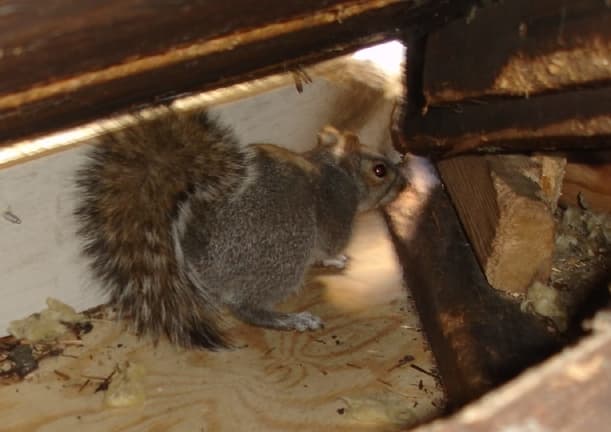If you’re not careful, squirrels may decide to live in your attic instead of where you normally store things or keep your home’s infrastructure. These quick and clever rodents can get into your attic through a number of common entry places. Knowing how they get in is important for keeping yourself free of infestations.
-
Gaps in the roof and eaves
Squirrels are great crawlers and can easily get around the outside of your house, especially the roof and eaves. They often take advantage of cracks, holes, or gaps in the structure and edges of your roof to get into your attic. If needed, they use their sharp teeth to make these holes bigger. They can also get on your roof easily if tree branches hang over it.
-
Aisles and vents
Squirrels often get into homes through attic vents, exhaust vents, and chimney holes. Small animals like these can get through vents that aren’t properly sealed or screened. Squirrels may get into your attic through a chimney if the flue is open or the chimney cap is broken.
-
Soffits and fascia wood
Squirrels may take advantage of weak spots in your home’s soffits and fascia, which are the beneath and outside coverings of your roof overhangs. Rats and mice can get into your attic through these places if they are not well taken care of or if there are holes in them. They are known for making their entry points with their strong teeth.
-
Systems for ventilating the roof and attic
Squirrels can also get into your attic through the roof or vents in the attic. It can be easy to get to roof vents, especially ones that don’t have screens to protect them. For squirrels, your attic is a good place to live because it has vents, fans, and other holes that let air in and out. They can also hide from the weather.
-
Gaps in the construction
Small holes and gaps may be left behind when your home is being built or remodelled. These holes can be used by squirrels to get in. There may not have been any gaps when your house was first built, but over time, normal wear and tear can make spaces for these pests to get in.
-
Ways to get into the attic from other buildings
Sometimes, squirrels get into attics not by climbing up on your house’s roof, but by coming in from a nearby building, like a shed, barn, or tree. Once they get to your roof, they can quickly find weak spots where they can get in.
-
Siding or fascia that is damaged
If your home’s siding or fascia is broken, squirrels may be able to get in. To get into your attic, they might chew their way through wood siding, aluminum framing, or any other weak material.
Stopping squirrels from getting in
To keep squirrels out of your attic and away from the damage and noise they cause, you must keep them out. Check the outside of your house often, including the roof, soffits, eaves, vents, and chimneys. Fix any damage, seal any holes, and add screens or covers to weak spots to keep them safe.
Squirrels might jump on your roof if tree branches hang over it, so cut them back. Make sure your attic has good airflow, but make sure that any vents have screens or caps on them to keep things safe.
If you think squirrels are in your attic or find any signs of an invasion, like noise or damage, you should act right away. When squirrels get into your home, they can do a lot of damage. Often, the safest and most gentle way to get rid of these unwanted guests from your attic is to call a professional pest control service.
Technicians at Squirrel Control Bolton use the best materials to protect your property against squirrel break-ins. They will use thick galvanized steel mesh and heavy gauge flashing, and we know to provide people with custom solutions unique to your case. We can squirrel-proof roof vents, gable vents, drip edges, soffits, ridge vents, wall vents, chimneys and more.
